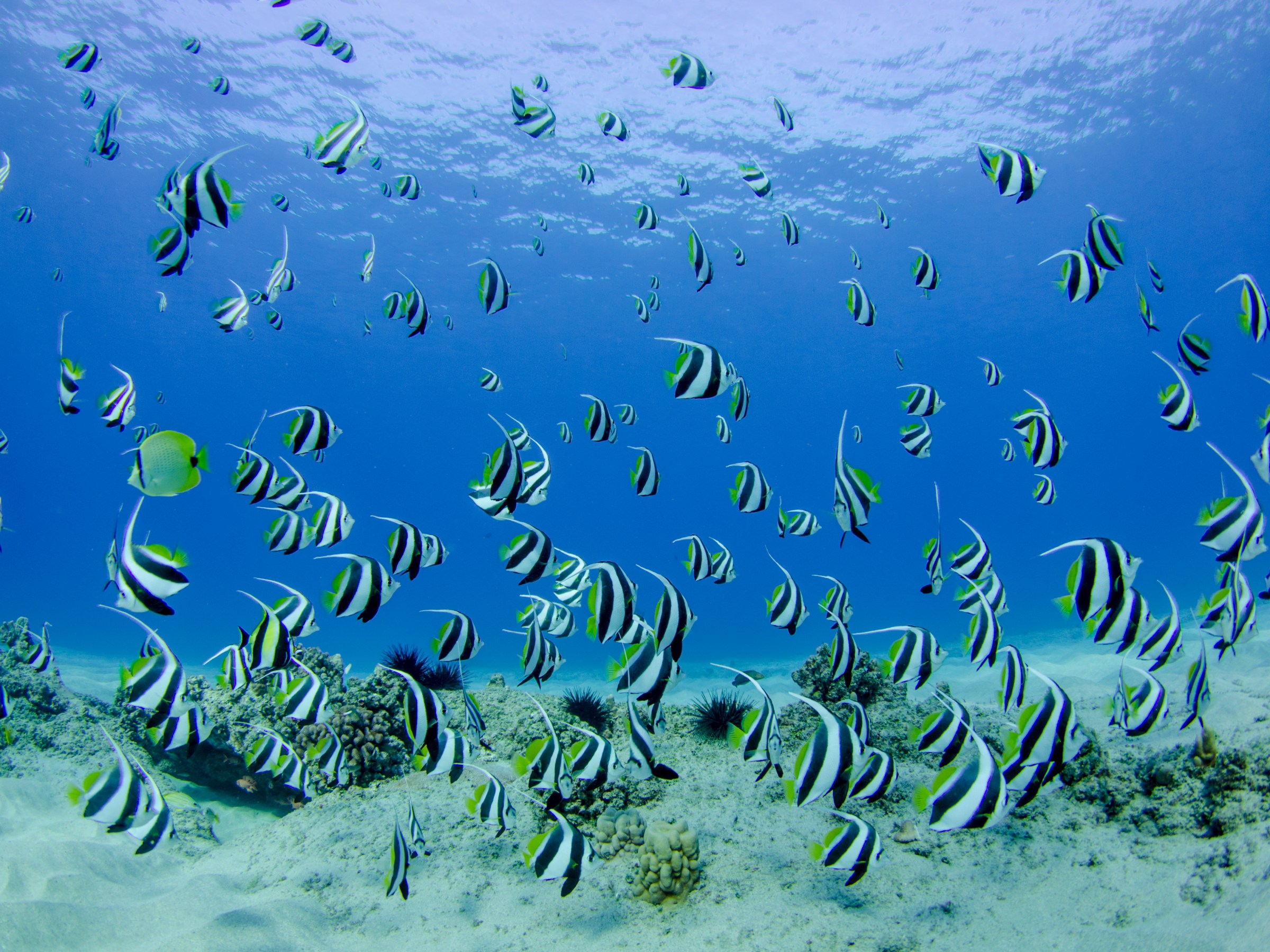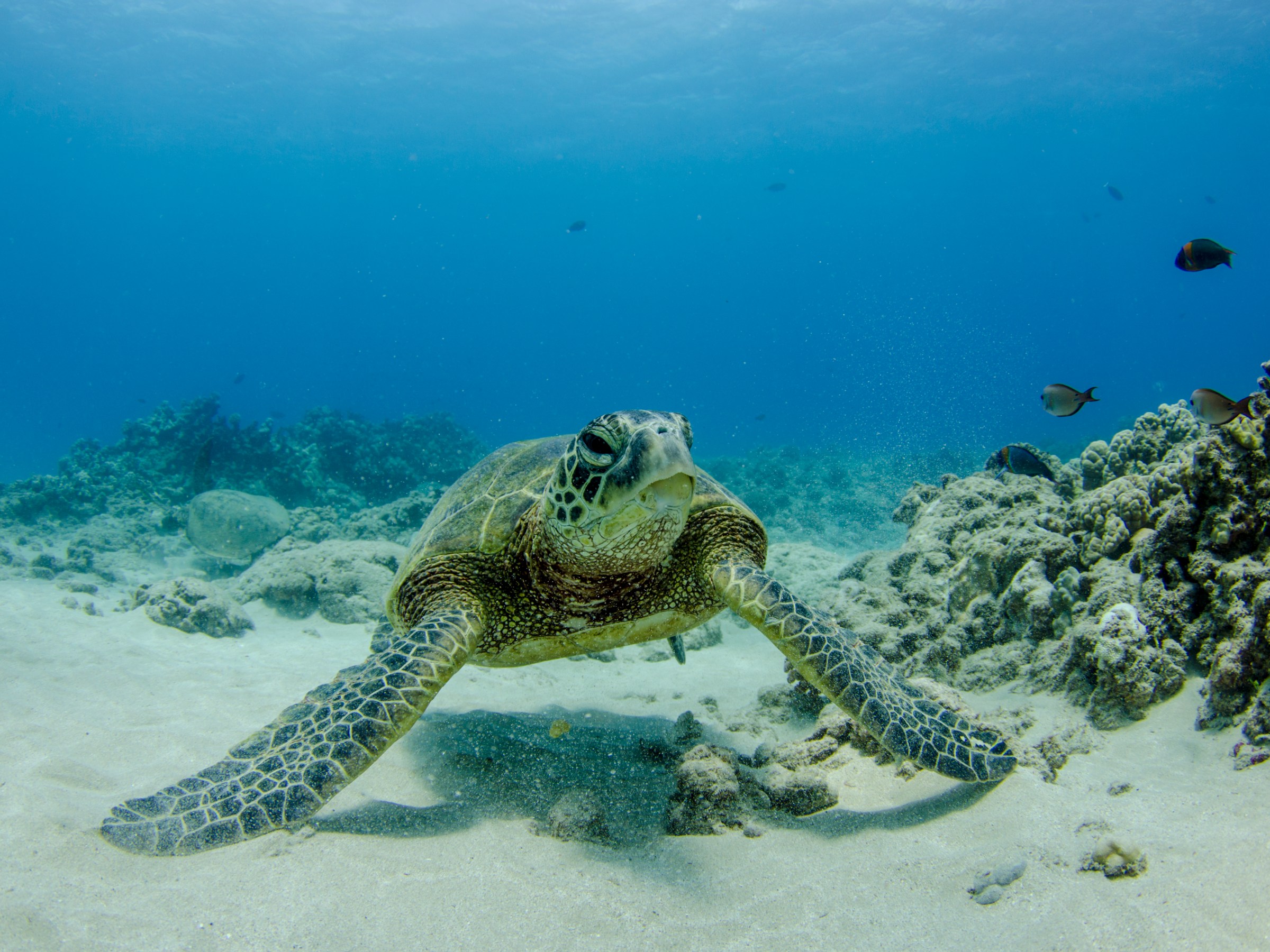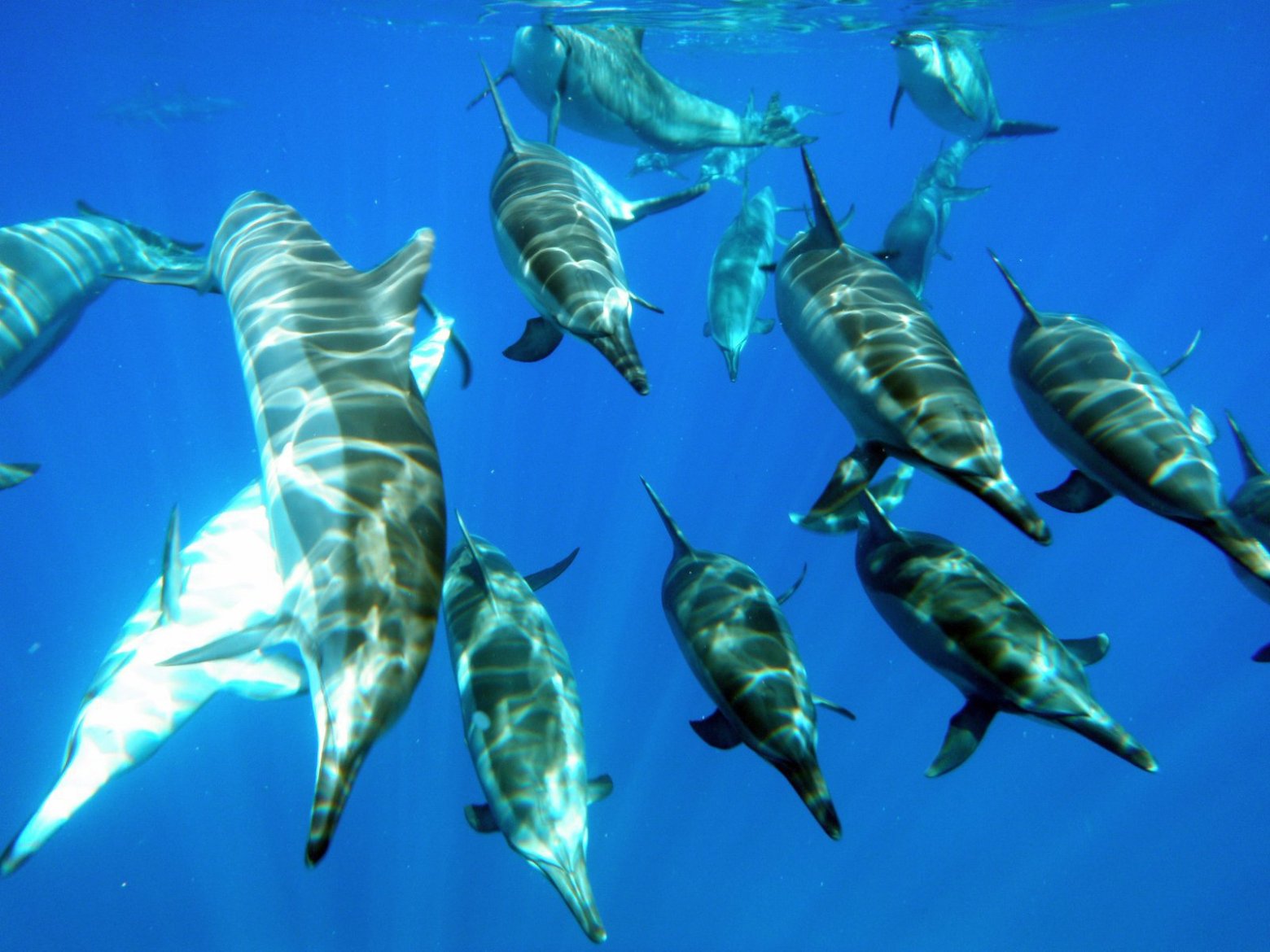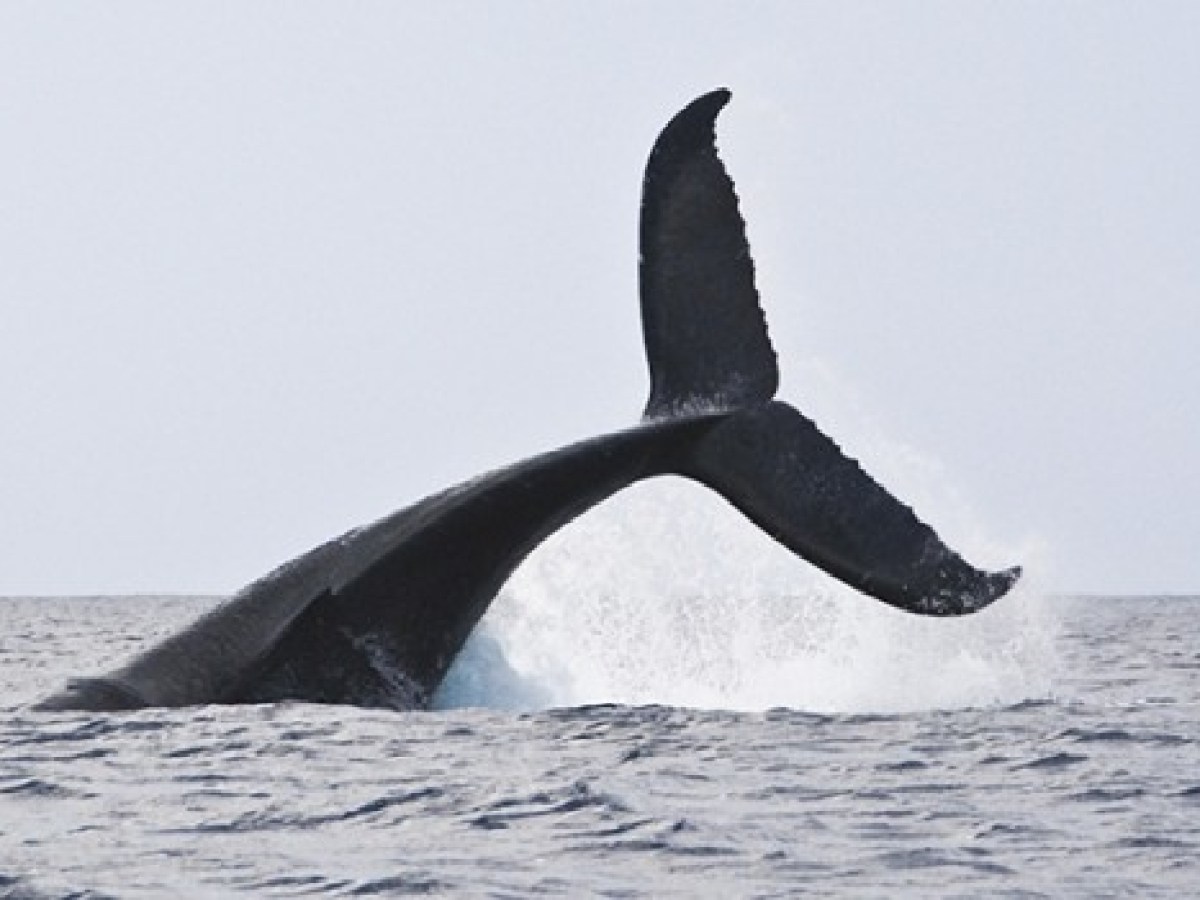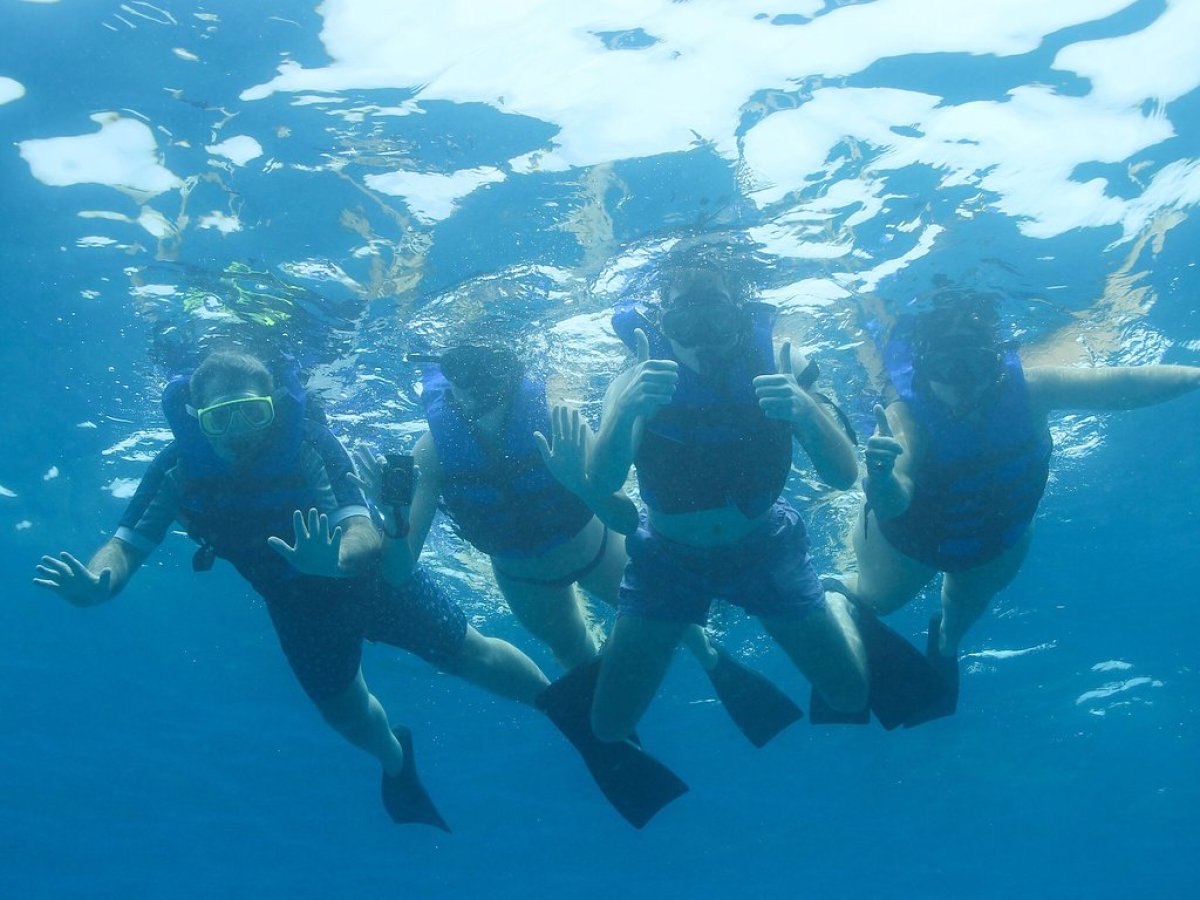Meet Our Underwater Friends
Dolphins
Ancient Hawaiians have been creating mythology around them, Mark Twain wrote about them, and scientists have been studying them; Hawaiian spinner dolphins have made their mark and their home on the west side of Oahu since well before recorded time.
These days, spinner dolphins are seen on a daily basis on the west side of Oahu. Spinners travel far off shore at night to their feeding grounds and return close to shore in shallow waters to socialize, nurse their young, and rest.
Spinner dolphins are the most common cetacean found around the Hawaiian Islands. They average 6 feet (2 m) in length and 175 pounds (80 kg). Pod size ranges between 10 and 100 individuals.
Resting behavior is characterized by swimming in tight groups, surfacing synchronously to breathe, and gliding along the sandy bottom in a “carpet” formation. Aerial activity, such as spins, head, and tail slappings, increases as they awaken during the late morning hours and through the afternoon.
Humpback Whales
Humpback whales migrate to the Hawaiian Islands during the winter months, mid-December to March. The humpback whales come to the Hawaiian Islands for the purpose of calving and mating; the warm inshore waters surrounding these islands offer the young whales protection from predators as they build up enough body fat for their 3,000-mile journey north.
Males reach 43 feet (14 m) and females 45 feet (15 m) in length and weigh 35 tons, on average. Males produce intricate songs, only during the mating season. Whale songs are composed of themes, which in turn are composed of phrases.
These acrobatic animals are known for breaching and slapping the water with their tails and pectoral fins. This type of whale can be found from as far south as South America, as far north as Alaska, in Australia, New Zealand, as well as a number of south Pacific islands, but one of the best places to view them up close is in the warm waters of the Hawaiian Islands. Humpback breaches are spectacular!
Guidelines For Viewing Dolphins
-
This is a law that we support and defend. It is time to give the local Spinner Dolphin community more space and control of their own surroundings.
Please see NOAA Fisheries website on this topic for official text on the matter.
We will explain to you as we understand and apply to our viewing of the Spinner Dolphins.
-
As we locate a pod of Spinner Dolphins, we must maintain a distance of 50 yards. That is both on our vessel and while in the water. A vessel or person may not approach a Spinner Dolphin closer than that. A vessel or person may not “pursue” of “follow” said dolphin or pod.
-
If our vessel is anchored and our engines are not engaged, the Spinner Dolphins may approach on their own. This includes if our guests are already in the water, snorkeling at a sea turtle reef. If that happens, guests must stay still and not pursue. If the Spinner Dolphins linger, then the crew will ask you to come back to the boat and we will pick up anchor and wait for the dolphins to leave the area before continuing our activities.
-
With the time saved from the consuming task of dropping with Spinner Dolphins, we have more time to find other offshore dolphins. These bigger and deeper species are out there for us to view. These other marine mammals include Bottlenose Dolphins, Kiko (Spotted) Dolphins, Pilot Whales, False Killer Whales, Pygmy Whales and in the Winter, Humpback Whales.
-
Trust us, we know what we are doing. Our job is to keep you out of the courtroom and in compliance while enjoying the plethora of marine life we find on the west side of Oahu.
-
We are a team of Marine Biologist and Naturalist. Our passion is felt by all and you will feel good staying eco friendly and compliant for the good of our Local Spinner Dolphins.
-
Our morning Dolphin Excursions still come with a return trip guarantee.
-
We will have more time to visit some of the best snorkeling sites with sea turtles, tropical fish and reef.
-
Our local community of Kama’aina will be grateful for your care of these animals. Spinner Dolphins mental and physical health will ensure the coming generations of Hawaiians to enjoy them as their ancient ancestors have.
Observe The Law:
Dolphins are protected by U.S. Federal law under the Marine Mammal Protection Act of 1972, Amended in 1994. Under the act, it is illegal to harass, hunt, capture, collect, or kill any marine mammal. Swimmers and boaters should make every effort to avoid disturbing them in their natural environment. For a more detailed look at the law, please ask the captain for the Marine Mammal Protection Act Record.
Know Your Limits:
Stay within a safe distance from the boat, (a safe distance would be only as far as your willing to swim back alone.) Watch for changing weather and sea conditions (the captain and crew are also watching for changes.) If you have any concerns about your safety before you get in the water stay aboard the vessel, while in the water, use the signal shown to you by our crew for help if you feel you need it, we will come to your aid.
Common Behaviors:
Hawaiian Spinner Dolphins are found feeding in the coastal waters offshore at night. During the day, they move into waters near shore and protected bays to rest and play. Dolphins at rest will surface for only brief periods of time, sustaining long deep dives together as a pod for 1.5 to 2 minutes. In this state, they show little interest in humans. Play mode is indicated by an increase in their aerial behavior, vocalization, splitting into smaller groups, and speeding up, generally favorable conditions for dolphins to initiate an encounter with humans.
Sustainability Commitment Statement
We here at Dolphin Excursions Hawaii, Inc. support the Hawaii Ecotourism Association’s principles of sustainable tourism, which addresses operating principles in the following content areas:
- Environmental Management
- Staff Management
- Interpretation Management
- Consumer Evaluation Management
- Marketing Management
For more information, please visit: http://www.hawaiiecotourism.org/

